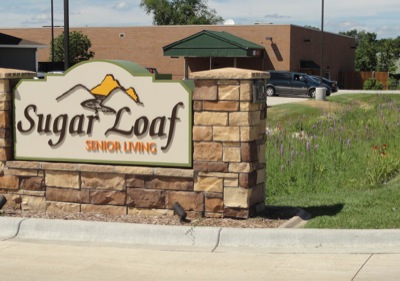
LEFT: Principal Rocky Sandcork and Hope Lutheran High School students pause for a snapshot after removing non-native plants from a storm water retention basin at the entrance to Sugar Loaf Senior Living. CENTER: An overflow drain moves water to the City storm sewer system if it over-fills. RIGHT: Near Mankato Street a second basin collects water from a large parking lot.
When Sugar Loaf Senior Living was built in 2012, owners followed local building and storm water permitting processes, including development of a storm water plan. The plan showed how land would be shaped to keep rain and melting snow from roofs, sidewalks and parking lots on the site, so it could sink into the soil rather than run off, untreated, to the Mississippi River.
Two basins capture water on the east and west ends of the property now. They’re gardens of native Minnesota plants that thrive in a wet/dry cycle. These low places filter pollutants and contribute something important to people, too.
Allison Briggs, executive director, says the bright, hardy plants are beginning to create an oasis in their high-traffic area on Mankato Avenue across from Lake Winona. “Because of our location, it isn’t easy for residents to walk outside and experience nature, so these gardens help. One couple walks the grounds every day now, and residents who can’t get outside have something nice to look at.”
Sugar Loaf also provides raised garden beds and a safe, inviting outdoor area for people with memory loss. Briggs says these natural settings heal, create connection, and have attracted people to learn and help.
Chuck Kernler is one. When visiting his wife in respite care last summer, he saw work to be done in the basin gardens. With kids from Hope Lutheran High School he’s since removed loads of vegetation threatening the young prairie plants. “None of the students had experience with this,” he says, “but they dug in!” Chuck also included residents in learning about rain gardens and native plants.

 4 Retention Basin Benefits
4 Retention Basin Benefits
1) Landscaping attracts positive attention, creates goodwill and adds beauty to the community.
2) Minimize storm water utility fees, to improve cash flow.
3) Walking the “green” talk attracts people and builds business.
4) Improve local streams and water quality.
If you have a business, take a look at your site. Are there places where basins or parking lot plantings can keep silt, oil, chemicals and debris from washing into the storm sewer, ditch or nearby stream? How can you attract people with plantings?

